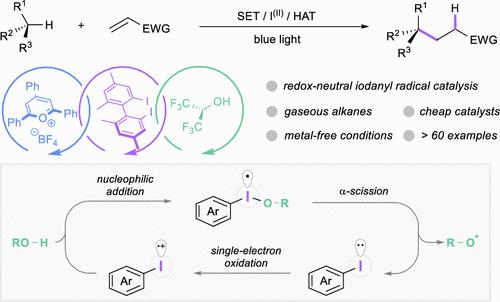协同碘基自由基和光氧化还原双催化直接C-H键功能化
IF 13.1
1区 化学
Q1 CHEMISTRY, PHYSICAL
引用次数: 0
摘要
碘基自由基催化是高价碘催化的前沿,具有不同于传统I(I)/I(III)和I(III)/I(V)体系的独特反应活性。本研究提出了一种创新的光催化策略,通过高效的I(I)/I(II)催化循环产生和利用碘酰自由基。利用可见光催化转化芳基碘化物,我们在氧化还原中性条件下实现了对碘基自由基中间体形成的精确控制。所开发的体系具有多功能性,特别是在醇作为氢原子转移催化剂的活化方面。我们展示了这种碘基自由基在挑战C-H键功能化方面的催化能力,包括轻烃(如甲烷、乙烷和丙烷)的活化。机制研究揭示了碘酰物种在促进HAT过程中的关键作用。这项工作扩大了高价碘化学的范围,为合成有机化学提供了一个有价值的工具,为以前具有挑战性的转化开辟了道路。本文章由计算机程序翻译,如有差异,请以英文原文为准。

Synergistic Iodanyl Radical and Photoredox Dual Catalysis for Direct C–H Bond Functionalization
Iodanyl radical catalysis represents a frontier in hypervalent iodine catalysis, offering unique reactivity distinct from those of traditional I(I)/I(III) and I(III)/I(V) systems. This study presents an innovative photocatalytic strategy for generating and harnessing iodanyl radicals through an efficient I(I)/I(II) catalytic cycle. Using visible-light photocatalysis to convert aryl iodides, we achieve precise control over the formation of iodanyl radical intermediates under redox-neutral conditions. The developed system exhibits versatility, particularly in the activation of alcohols as hydrogen atom transfer catalysts. We show the power of this iodanyl radical catalysis in challenging C–H bond functionalizations, including the activation of light hydrocarbons such as methane, ethane, and propane. Mechanistic investigations reveal the crucial role of iodanyl species in facilitating HAT processes. This work expands the scope of hypervalent iodine chemistry and provides a valuable tool for synthetic organic chemistry, opening avenues for previously challenging transformations.
求助全文
通过发布文献求助,成功后即可免费获取论文全文。
去求助
来源期刊

ACS Catalysis
CHEMISTRY, PHYSICAL-
CiteScore
20.80
自引率
6.20%
发文量
1253
审稿时长
1.5 months
期刊介绍:
ACS Catalysis is an esteemed journal that publishes original research in the fields of heterogeneous catalysis, molecular catalysis, and biocatalysis. It offers broad coverage across diverse areas such as life sciences, organometallics and synthesis, photochemistry and electrochemistry, drug discovery and synthesis, materials science, environmental protection, polymer discovery and synthesis, and energy and fuels.
The scope of the journal is to showcase innovative work in various aspects of catalysis. This includes new reactions and novel synthetic approaches utilizing known catalysts, the discovery or modification of new catalysts, elucidation of catalytic mechanisms through cutting-edge investigations, practical enhancements of existing processes, as well as conceptual advances in the field. Contributions to ACS Catalysis can encompass both experimental and theoretical research focused on catalytic molecules, macromolecules, and materials that exhibit catalytic turnover.
 求助内容:
求助内容: 应助结果提醒方式:
应助结果提醒方式:


